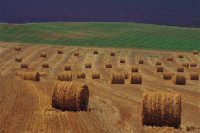

To send a message to an author, click on the author's name at the end of the article.
This Month in Ag Connection | Ag Connection - Other Issues Online

Summer is an active time of the year. Kids are out of school and weather encourages outdoor activities attracting many people to the countryside. Following lunch you step out of the house on to your front porch for a panoramic view of your farm. As you scan your acreage: first, you see an uninvited stranger fishing in your pond which is near the highway; second, you see one of your friends from town gathering some of your sweet corn (you invited him to harvest some corn for his family's use); and third, you observe that the tire repairman has arrived and is fixing the flat tire on your tractor. What are your responsibilities to these people while they are on your property and what liabilities might you incur should injuries be suffered by any of these three visitors? The answer to these questions hinges on the legal classification of the farm visitor. Visitors may be divided into three legal categories: trespasser, licensee, and invitee.
A trespasser is any person on your property without your consent and is there solely for his or her own benefit (the person fishing in your pond). Licensee is a legal category for someone who is on your property with your consent but is there for his or her own personal benefit (the friend picking sweet corn for his use at no cost). An invitee is a person who is on your property with your consent and is there either for your benefit or for your mutual benefit (the individual repairing your tractor tire).
Regarding trespassers, ordinarily you are not liable for injuries they suffer while on your land, unless the injury is a result of your intentional actions. It is important to note that you may only use reasonable force to remove a trespasser from your property. However, the force considered reasonable will depend on the circumstances of each situation.
Although a licensee is on your property for only their benefit, given they have your permission to be there, you have a greater degree of legal responsibility to protect them from injury. Missouri law requires a landowner to warn a licensee of usual or unusual conditions or situations which involve an "unreasonable risk" of which the landowner is aware and which a reasonably prudent person would not discover - until too late. You should be aware that trespassers may become licensees after discovery if you fail to remove them from your property. The issue of consent is critical, and confusion often exists in determining if a visitor is a trespasser or a licensee. This results because permission can be either expressed or implied. If a trespasser is injured while on your property, you can "bet the farm" their attorney will claim they were a visitor with your implied consent because you were aware of their trespass or that it was common knowledge you allowed that activity on your property (i.e. fishing, hunting, etc.).

Your legal responsibilities to an invitee are even greater than to a licensee. Your duties to an invitee are two-fold, a duty to warn and a duty to inspect. First, you have a duty to warn the invitee of known hidden dangers and, secondly, you have a duty to inspect your property for such dangers. Thus, you could be held liable for injuries suffered by an invitee from a hidden danger which you could have discovered by a reasonable inspection of your property.
Several changes to the trespass laws and landowner liability laws have been enacted in Missouri within the past several years. In today's legal environment and given the nature and expansiveness of most farming operations, understanding your legal responsibilities to visitors and taking adequate steps to minimize your financial exposure is only good business risk management. If you have concerns regarding liability for visitors on your property, a visit with your attorney may pay dividends.
(Parman R. Green, MU Extension Ag Business Mgmt. Specialist)
This Month in Ag Connection Ag Connection - Other Issues Online
Tall fescue is our most widely used forage. Unfortunately, most tall fescue is infected with an internal fungal (called an endophyte), producing an alkaloid toxin (ergovaline), toxic to grazing animals.
Some of the effects of tall fescue toxicosis in cattle:
In horses:
Symptoms in cattle include:
A recent discovery is the effects last for up to six weeks. These effects will continue even after livestock are put on different forages or grain based feeds in feedlots.
There are two concepts for managing endophyte infected tall fescue. They are alkaloid management and the Garner concept. The Garner concept tries to overcome the toxins with implants, supplements and adding legumes into the infected tall fescue pastures.
Following are some approaches to manage fescue toxicosis.
Fertilize Carefully | |||
| Nitrogen Fertilizer (lb./ac.) | |||
|---|---|---|---|
| 0 | 60 | 120 | |
| Ergovaline (ppb) | |||
| Leaf | 258 | 306 | 485 |
| Stem & Sheath | 494 | 561 | 1003 |
| Seedhead | 895 | 1050 | 1488 |
(Authors: Jim Jarman, Wayne Crook, Agronomy Specialists and Craig Roberts, State Forage Specialist)
This Month in Ag Connection | Ag Connection - Other Issues Online
Given this year's relatively high level of grain prices (current local prices and those listed on the board of trade for this fall), many farmers are considering marketing strategies that involve futures and options. It is critical to understand the distinction the IRS makes between hedging and speculating.
If farmers enter into commodity futures contracts or options to protect against the risk of unfavorable price fluctuations, and if these contracts cover amounts of the commodity within the normal range of production, the transactions would be considered hedging transactions. These transactions can take place at any time the farmer has the commodity under production, has it on hand for sale, or reasonably expects to have it on hand.
A person is speculating if they enter into futures or options market transactions with the motive of making money on the rise or fall of the market price. Selling cash grain and re-owning "paper grain" is often considered by producers and market advisors to be a risk management strategy. However, since the producer re-owns the "paper grain" in anticipation of capturing higher prices, the futures transaction is considered by IRS to be speculative.
In a hedging transaction a farmer enters into the futures or options market taking an opposite position they have outside the futures market. A hedge results in a gain or loss in the futures or options market, offsetting the gain or loss in the physical commodity. Thus, this type of futures or options strategy is entered into for the purpose of price insurance (hedging), not price speculation.
The tax consequences between speculation and hedging are significant. Speculative futures and option transactions result in a capital gain or loss. These capital gains and losses are reported on Schedule D and the maximum net capital loss deduction per year is $3000.
In contrast, the gain or loss on hedging is ordinary gain or loss and is reported as business income or loss on Schedule F. While hedging profits are reported as ordinary income and subject to self-employment tax, on the flip side there is no maximum loss deduction relative to hedging transactions.
(Author: Parman R. Green, MU Extension Ag Business Mgmt. Specialist)
This Month in Ag Connection | Ag Connection - Other Issues Online

Do you know your haying costs? They may be higher than you think. In Feb. 1998 we published some estimates of haying costs in Ag Connection.
The following table shows part of that data. The whole article can be seen at: http://agebb.missouri.edu/agconnection/newsletters/is-98-02.php#Hay
| Implement | Cost | Cost/T Various Total Production | ||
|---|---|---|---|---|
| 100T | 400T | 800T | ||
| Mower/Conditioner | $10,000 | $30.21 | $10.52 | $7.24 |
| Rake | $4,600 | $15.82 | $6.76 | $5.26 |
| Baler | $19,000 | $52.45 | $15.04 | $8.80 |
| Total | $33,600 | $98.48 | $32.32 | $21.30 |
| Costs include depreciation, interest, operating cost, labor, and tractor. | ||||
Other haying costs can be seen in an article from the Virginia Cooperative Extension at: http://www.ext.vt.edu/news/periodicals/fmu/2001-04/haymachinery.html
To estimate your haying costs, software from Oklahoma State University can be downloaded from: http://dasnr.okstate.edu/agmach/
You might also like to compare haying equipment costs to the 2003 custom rates. If you can get your hay put up at a lower cost by someone else on a timely basis, perhaps you should consider hiring it done. UMC Guide 302, 2003 Custom Rates For Farm Services is located at the following web site: http://extension.missouri.edu/publications/DisplayPub.aspx?P=G302
With the cost of hay production, you should do everything possible to be sure the hay you do harvest is of the best quality. You can find some good information on making quality hay at a web site from Oklahoma State University: http://www.okstate.edu/ag/agedcm4h/pearl/e826/ch11.htm
Other information on conditioning hay can be found at a Kansas State University Site: http://www.oznet.ksu.edu/library/ageng2/mf989.pdf
This Month in Ag Connection | Ag Connection - Other Issues Online
Certified sprigs of Ozark Bermudagrass will be available to producers this year. The Missouri Seed Improvement Association is handling the distribution of this in Missouri. For more information on this cultivar see: http://www.ozark.missouri.edu
(Author: Don Day, Natural Resource Engineer)
This Month in Ag Connection | Ag Connection - Other Issues Online
Publishing Information
Ag Connection is published monthly for Northeast and Central areas of Missouri producers and is supported by the University of Missouri Extension, the Missouri Agricultural Experiment Station, and the MU College of Agriculture, Food and Natural Resources. Managing Editor: Mary Sobba.